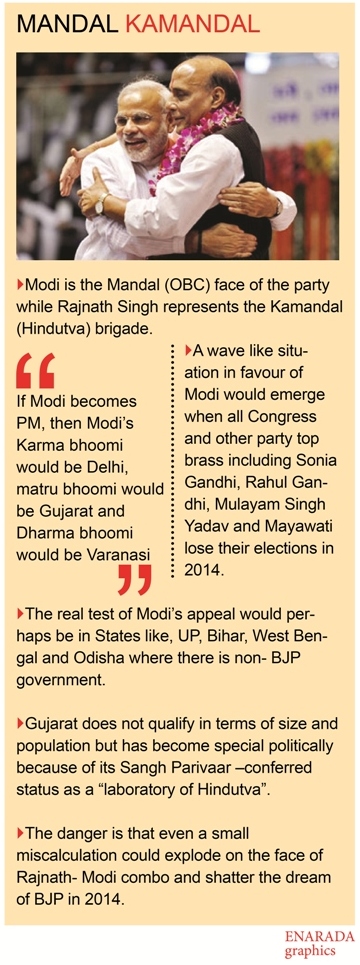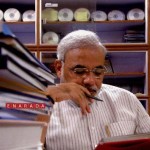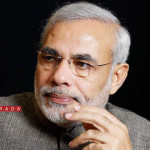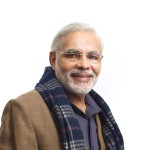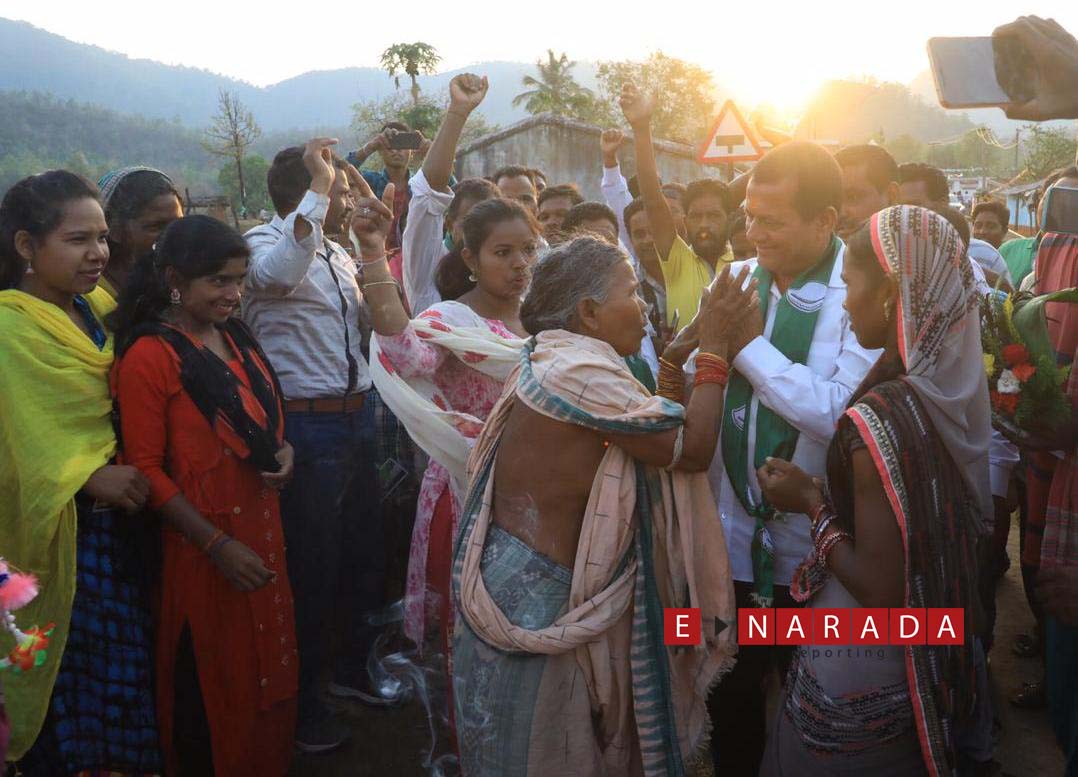By AJAY N JHA
Using some known epithets and idioms has become a fashion for many politicians during the five yearly election season. The Congress party satraps make it a point to use “rocket science” at every occasion to impress their voters and colleagues because their leader used it once while the BJP leaders emphasize on “the Modi wave across the country”.
In reality however, the Congress party could not understand the basics of “poll science” in the same way many BJP leaders are able to see the “Modi wave sweeping across the country” even when they could hardly point towards a little layer of haze on the horizon.
Rocket science is a complex mechanism where thousands of accurate calculations and calibrations go into making a rocket launch into the space. In the same way, many calculations and ground inputs help in understanding the poll arithmetic and chemistry of voters mood.
On the other hand, a wave is defined as a burst of emotions, a swell along the surface caused by wind, a sudden occurrence of something. A political wave is caused by one personality whose appeal, charisma and support is all pervasive sweeps across the country and bring him bountiful gains in terms of numbers.
That way, Lok Sabha polls 2014 has already started turning out like a thriller, thanks to a series of opinion polls and surveys which have been cooking and dishing out various kinds of date and projections. A few BJP leaders appear to have taken as gospel truth and they keep on blaring in front of media ad nauseum about those narratives and turn trivia into titanic by saying that the “ Modi wave is sweeping across the country this time”.
The fact however remains that the BJP is certainly going to emerge as the single largest party, many other equally powerful and engrossing sub-plots are vying for attention. The BJP top brass is confident that it would cross the 272 plus mark on his own steam while Congress Vice-President is still dreaming about the return of UPA-3 comfortably.
Most of these poll surveys are not yet prepared to give BJP more than 220 seats. The moot question is if crossing 200 mark would be called a wave? If winning 200 plus seats in Lok Sabha polls is a sign of wave, then one can safely say that there was a Manmohan Singh wave in 2009 even without the Prime Minister bothering to contest himself.
Perhaps only such “wave like” situation emerged in 1984 when India Gandhi’s assassination helped Rajiv Gandhi win more than 400 seats and most of the opposition top brass including Atal Behari Vajpayee to Hemvati Nandan Bahuguna lost in their own backyards. Following that logic, a wave like situation in favour of Modi would emerge when all Congress and other party top brass including Sonia Gandhi, Rahul Gandhi, Mulayam Singh Yadav and Mayawati lose their elections in 2014 . But that is not going to happen in any case. So where is Modi wave? In addition, one could understand the sign of Modi wave if the BJP wins at least 65 to 70 out of the total of 80 seats from Uttar Pradesh by contesting from the historic city of Varanasi. That too seems quite unlikely.
The sign of Modi wave could be considered if BJP is able to brushes out AAP from Delhi lock, stock and barrel. But even that seems unlikely.
On the face of it, the Congress could perhaps half the number of 206 seats it won in 2009 Lok Sabha polls. But that is not going to be transferred into BJP kitty either. For example, BJP would have a tougher fight against AAP in Delhi and the same scenario could perhaps be repeated in Andhra Pradesh where the regional parties could be bagging more seats tumbling out of the Congress trolley. Most of the other States like Rajasthan, Gujarat, Madhya Pradesh and Chhattishgarh are already in BJP kitty where the party is expected to do well in any case.
The real test of Modi’s appeal would perhaps be in States like, UP, Bihar, West Bengal and Odisha where there is non- BJP government. If BJP wins at least 10 seats in Odisha and West Bengal each, 60 plus seats in Uttar Pradesh and over 30 seats in Bihar, then it could be conclusively established that Modi’s campaign won over converts from every political faith.
As a veteran commentator said “Modi’s decision to descend on the Ultimate seat of Hindutwa (Varanasi) has been celebrated with vigour heard of only in mythological tales about reincarnation of Lord Shiva Himself. Going by the euphoria and slogans replacing Mahadev with Modi, it is easy to believe that Varanasi’s day of deliverance is near. Never mind Ram Rajya in Ayodhya, his followers are convinced that at least a symbolic Ram Rajya in the heart of Hindutwa is about to become a certainty. This is the real message of Modi’s Varanasi avatar”.
Another poll watcher said “if he becomes PM, then Modi’s Karma bhoomi would be Delhi, matru bhoomi would be Gujarat and Dharma bhoomi would be Varanasi”.
It is with this dream in the mind that both RSS and BJP had thought of a unique combination of Rajnath Singh and Modi as the mascots and combination of “Mandal with kamandal” as the poll agenda. It is this belief that has made the BJP embark on such an audacious expedition by packaging Prime Ministerial aspirant Narendra Modi as a development-oriented backward class leader in the crucial Hindi heartland. It is this communal polarization and the speculative Modi factor game which the BJP is trying to play through a tight rope-walk approach.
Both Modi and BJP are aware of the cliché that the route to power at the Centre goes to Delhi via Uttar Pradesh which sends 80 members to the Lok Sabha and reaching this target by being able to successfully negotiate this tricky and complicated terrain of entrenched caste politics would be a unique moment and landmark in Indian electoral history. Interestingly enough, Uttar Pradesh has produced most of the country’s Prime Ministers. On the other hand, Gujarat does not qualify in terms of size and population but has become special politically because of its Sangh Parivaar –conferred status as a “laboratory of Hindutva”.
The recipe is indeed extraordinary and has the potential of changing the entire course of politics in India for many decades to come. However, the danger is that even a small miscalculation could explode on the face of Rajnath- Modi combo and shatter the dream of BJP in 2014.
BJP leader Mukhtar Abbas Naqvi said that the era of Mandal and kamandal (OBC reservation and Hindutwa) was over long ago. “Whenever BJP fought on issues like development, education, security and employment, the party has done well. Whenever we fought on negative and non-issues, we performed badly. Almost 70 percent of the Indian voters are below the age group of 40 years and they look forward to development of the region and the state as well as progressive politics”.
Naqvi may be right in his statement but he is not prepared to accept that combining Mandal with Kamandal is like putting fire and water together and creating “steam” out of it to run the BJP engine takes a lot of experience and expertise. Modi is the Mandal (OBC) face of the party while Rajnath Singh represents the Kamandal (Hindutva) brigade.
As a commentator wrote “The RSS-BJP combine is attempting the most audacious political experiment since the formal mandalization and the consequent fragmentation of Indian politics that came with VP Singh’s announcement of reservations for the OBCs 25 years ago.” He said that an attempt was being made to create a new look social chemistry by packaging and presenting Modi as an Avatar embodying both the OBC and upper caste Hindutva elements in varying proportions. This kind of cocktail in the imagination of RSS, should have great appeal among the OBS of Uttar Pradesh and Bihar which together have over 40 percent votes.
On the face of it, a major electoral success in 2014 LS polls would eventually be touted as a big achievement in terms of stitching together the upper caste Hindus and the OBCs who fought bitterly during the anti-Mandal agitation after the announcement of Mandal Commission recommendation report in 1989. But it would equally paradoxical because the same BJP had launched its Mandir agitation as a violent reaction to the Mandal report implementation. The BJP slogan then was to counter “mandal” with “kamandal” which represented the Ayodhya temple movement and the BJP’s calculations of unifying all castes under the Hindutva umbrella aided by the temple movement went haywire.
Later on, the BJP vacillation between Mandal and Kamdal also saw the back side of leaders like Kalayan Singh and Uma Bharti in the same UP and MP.
The statement of RSS ideologue MG Vaida could be seen in this context when he said that “After the 1984 elections drubbing, BJP once again started chanting Hindutva. BJP came close to power but could sustain its strength. The party leaders had no patience and almost forgot Hindutva and its basic principles.The party came to power in 1999 but after losing it in 2004, it again turned towards Hindutva. BJP mentioned Hindutva in its manifesto in 2009 but it miserably failed to attract the common voters and citizens in the country”.
MG Vaidya went to the extent of saying that “if BJP gives up Hindutva, regional parties like Trinamool Congress, BJD, TDP would rush to it and internal bickering in JD (U) would also finish”.
The biggest loser of the Mandal Vs Kamandal tussle was the Congress party as its traditional support base got eaten up by the emergence of the new backward caste politics specially in Bihar and UP and the rise of leaders like Sharad yadav, Lalu Prasad, Mulayam Singh yadav and Nitish Kumar was a direct fall-out of this.
The current RSS- BJP experiment of projecting Modi as its Prime ministerial candidate expecting that it would fire up the imagination of OBC and Dalits and bringing in leaders like Ramdas Athawale, Dr Udit Raj, Ram Vilas Paswan and few others into its fold is still untested. Moreover, the history of confrontation between the OBC and the Upper caste Hindutva forces would not be forgotten easily.
This move, aimed at eroding the electoral base of the OBC leaders like Nitish Kumar, Mulayam Singh yadav and Lalu Yadav would be easier said than done. On the contrary, it would produce equally sharp feeling of resentment among the upper caste Hindus.
Already, there are pockets of discontent in the BJP camp at the raw deal given to senior Brahmhin leaders like Murli Manohar Joshi, Kalraj Mishra and Lalji Tandon. Bramhins constitute almost 11 percent of UP voters and they have always voted tactfully like Muslims and it is also true that Bhramhins and Rajputs have got along together most of the time. In the 2012 assembly polls, the BJP barely secured 15 percent of the total votes polled and won just 47 out of the total of 402 seats. It finished second in 55 assembly segments, third in 100 seats and BJP candidates forfeited their deposits in 229 assembly seats.
At a time when both Samajwadi party (SP) and Bahujan Samajwadi party (BSP) are wooing the powerful Bramhin community by organizing sammelans, the BJP is working on beefing up Modi’s image as the face of “Hindutva and development” despite the Gujarat model proving to be a hype manufactured by Modi’s formidable media machine and which has been trashed by Arvind kejriwal as “farce”.
It is also pertinent to recall that the Brahmins had played an important role in ensuring the victory of the BSP in 2007. The erosion of the brahmin vote, coupled with the tussle between Vajpayee and Kalyan Singh had also ensured that the BJP’s tally fell from 58 in 1998 to just 27 seats in 1999 lok Sabha polls. A political observer in Lucknow said that “the BJP may gain seats due to a combination of communal polarization and division in secular votes. However, Bramhins can be expected to vote tactically, much like the Muslims, in terms of swinging it for the leading. Winning party and as such, BJP should not take it for granted any more”.
Under these circumstances, Modi as a personality has not been above board in his words and image at par with Vajpayee who could command unqualified respect from all quarters”. Modi’s caste card and that too, having played early, can have adverse impact on the voters in UP and Bihar” said a poll watcher. The effort of both BJP and RSS should have been to use the “undercurrent method” in caste engineering than such kind of blatant manifestation.
Moreover, the BJP too seems to be suffering from the same kind of resentment among the ticket seekers. In its bid to widen the canvass, the BJP has gone on accommodating many new comers and that has created huge amount of heart- burn among loyal workers.
For example, Madhya Pradesh has been a theatre of internecine bickering among the party men to the extent that five times MP from Shajapur- Dewas, Phool Chand verma shot off letters to RSS Chief and BJP President Rajnath Singh, questioning the manner in which tickets were distributed by the party in Madhya Pradesh.
BJP workers also protested against General VK Singh having given party ticket from Ghaziabad while Kiron Kher was shown black flag at Chandigarh by BJP workers.
In Delhi protest were also held by BJP workers against party ticket having been given to Bhojpuri actor Manoj Tiwari, Dalit leader Udit Raj and party’s senior spokesperson Meenakshi Lekhi and Art of Living’s Maheish Giri.
Even then, a section of media has gone on portraying Modi as the Prime minister in waiting and poll survey of NDTV- Hansa have gone to extent of giving 20 out of the total of 28 seats in Karnataka which seems to bit too far-fetched.
While there is no doubt that Modi is the biggest star of BJP at the moment but then the history of Indian polls in last 53 years has been replete with many interesting twists and turns. On the one hand was the case of a farmer from Hardanhalli village in Karnataka named HD Deve Gowda who could become the Prime Minister on the strength of just 16 MPs from his party while there was another extreme where the BJP patriarch L.K. Advani came clear closer to becoming the Prime Minister but missed by a whisper. One hopes history does not play some quirk game with Modi in the same way in 2014.
(Posted on March 18, 2014 @ 11.40pm)
(Ajay N Jha is a veteran journalist from both Print and Electronic media. He is Advisor to Prasar Bharti. The views expressed are his personal. His email id is Ajay N Jha <ajayjha30@gmail.com> )
The views expressed on the website are those of the Columnists/ Authors/Journalists / Correspondents and do not necessarily reflect the views of ENARADA.



